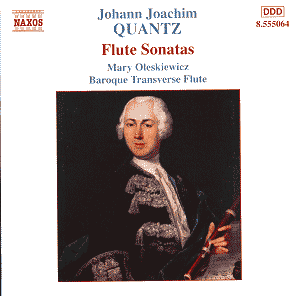Virtuoso, technical innovator, alumnus of the Dresden
School, Quantz was the flute composer of the eighteenth century.
His works, many written for Frederick II of Prussia (Frederick the Great,
whom Quantz taught) are voluminous and generally undated – though some
tangential evidence can be adduced from the apparent borrowings from
his contemporaries. His undoubted virtuosity was accompanied by a generous
and playful imagination and a stylistic imperative that embraced baroque
dance forms in all their rich variety. He wrote over two hundred sonatas
and over forty trios, a number of them displaying an admixture of inventive
chromaticism and vocal impersonation, taking Vivaldi and Hasse as his
preferred models.
The opening movement of the D major sonata sounds like
a real test of the player’s breath control, a taxing feat met with resilience
and flair by Mary Oleskiewicz and her transverse flute. The Arioso central
movement, which opens outside the home key and wanders with impressive
expressivity considering its relative brevity, serves notice of the
deeper-than-they-seem element to Quantz’s sonatas and trios. The galant
and attractive Alla Forlana finale wraps up a spirited opener. Speculatively
the G minor sonata is the earliest here – dating maybe from 1720 – and
its four-movement frame conforms very much to expected models. There
is a good double fugue in the second movement Allegro and an explicitly
vocalised recitative (filched from operatic tradition) before a nice,
plump Tempo di Minuetto conclusion. Jean-Françoise Beaudin joins
Oleskiewicz for the Trio sonata in D major (here backed by harpsichord
– elsewhere the fortepiano and cello make their mark in the imaginative
obbligato roles). The opening Largo is rather conventional, but the
flautists’ articulation is fine in the succeeding Allegro in a work
in which two long Allegros frame two short Adagios.
The aria-like opening of the C major Sonata is most
attractively done and the apparent nod to Hasse’s contemporary Cleofide
may help more accurately to date the Quantz (c1731) – it’s full
of vivacity and brisk clarity. Once again, in the opening of the G minor
Sonata, Quantz shows his splendid grasp of the vocal style – lyrically
and expressively – as well as dishing out some tough sounding leaps
in the central Allegro, one which tests breath control into the bargain.
In fact he cited his own writing here in his textbook on the subject
of technique. In the concluding E flat major sonata there is elegance
and charm, piquancy and registral change with much lyrical writing –
a model Larghetto opening in fact; a sopranino delicacy pervades it
as does a Handelian sturdiness in the Presto.
Thoroughly well performed by Oleskiewicz – words of
praise as well to cellist Stephanie Vial, harpsichordist and forte pianist
David Schulenberg and Jean-Françoise Beaudin – this is a delightful
example of sensitive and accomplished musicianship.
Jonathan Woolf
